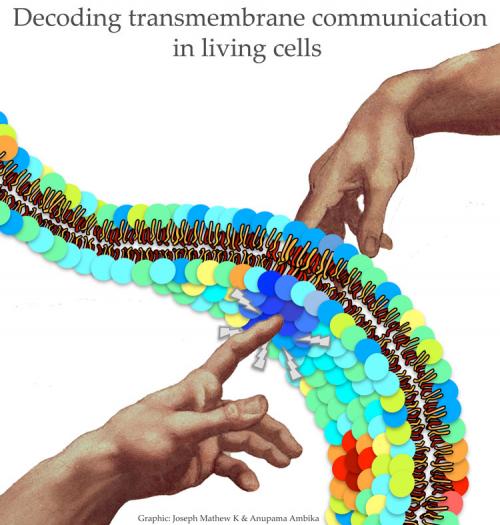Decoding transmembrane communication in living cells
Living cells aren't self-sufficient; they need to interact with their environment in order to survive. But these interactions are extensively controlled by the barrier called the cell membrane, a dynamic entity made up of lipids and proteins. Molecules are constantly passing in and out of the cell through the semi-permeable cell membrane, their movement often orchestrated by different forces and membrane components. This was the level of understanding of this barrier's structure and function, posited by the 'fluid mosaic' model developed by Singer and Nicholson in 1972. Little was known then about minute details of the driving forces at the nano scale.
Until now, the nitty-gritty of how information traverses the membrane had been left to cell biologists' countless hypotheses. Fast-forward to the 21st century, some of those assumptions have been put to rest by a recent study at NCBS. An interdisciplinary team has used living cells, synthetic lipid analogs and molecular dynamic simulations to understand transbilayer communication between molecules on either side of the bilayered cell membrane. The team consists of cell biologist Satyajit Mayor along with soft matter physicist Madan Rao and their teams at the National Centre for Biological Sciences, Bangalore, and synthetic chemists Ram Viswakarma (IIIM, Jammu) and Zhongwu Guo (Wayne State University, USA).
The team's studies at the nanoscale have revealed that Phosphatidylserine (PS) is a key component that mediates the communication between the lipids on the inner leaflet, and actin and lipid-anchored proteins on the outer leaflet. PS gets the message across because of the presence of long chain-containing lipids such as those found in 'solid fats'. That's how the components on inner and outer leaflets communicate. These studies show how integral PS is to signalling pathways of the cell, and therefore when absent results in irreparable damage.
"The uniqueness of the study lies in discovering a specific role for PS in nanocluster formation, a building block of 'lipid rafts' and how the chemistry of both the outer and inner leaflet facilitate this process. For this we have adopted an array of methods which combines biology, genetics, chemistry and physics to provide an explanation for the formation of nanoclusters" says Anupama Ambika Anilkumar, one of the first authors of the paper published online on 23 April, 2015, in the journal Cell.
Lipid rafts are microenvironments in the membrane made up of clusters of lipids and protein receptors, and are involved in molecule trafficking and assembly. Refuting early theories on the random combination of lipids to construct these lipid rafts, this study shows that the formation of these "nanoclusters" of lipids is an active process templated by the actin cytoskeleton on the inner leaflet. This understanding also points to further clues about the role of these clusters. They have been hypothesized to function as a 'sorting station' for components to be recruited for signalling events on the cell surface.
The discovery of PS as a vital component in the transmembrane communication would advance our understanding of the cell membrane's microenvironment. It would also help scientists understand how these nanoclusters function and what proteins are involved in their assembly. Additional experiments in Mayor's lab are underway to draw the complete picture of the cell's communications and the anchors of the PS species. These entities also play an important role in various other cell functions and are hence important problems to pursue.
"There is no earlier evidence of how these clusters are formed by lipidic interactions. My colleague and co-first author, Riya Raghupathy established methods to assay the role of long-acyl chain lipid species, and along with Parvinder Pal Singh, developed the synthetic analogues used in this study. Anirban Polley, working with Madan, conducted molecular dynamic simulations; both of these are an integral part of this study and I am grateful for having such terrific collaborators," said Anupama Anilkumar.
Decrypting this communication could help explain how signals are both read and interpreted by the cell, with implications for a number of diseases caused by alteration in lipid balance or composition. Understanding how these lipids, the "gatekeepers" of the cell, function might also help deter the progression of viral diseases, by potentially disrupting the interaction of membrane components with the viruses.
The paper can be accessed at:
http://dx.doi.org/10.1016/j.cell.2015.03.048
Suneha Mohanty is a writer with the Research Media Services Division of Gubbi Labs.

Comments
Post new comment